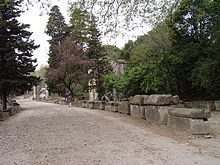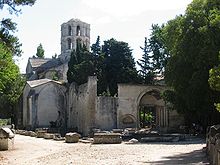Alyscamps
 An alley in the Alyscamps | |
| Location | Arles, Bouches-du-Rhône, Provence-Alpes-Côte d'Azur, France |
|---|---|
| Coordinates | 43°40′17″N 04°38′13″E / 43.67139°N 4.63694°E |
| Type | Necropolis |
| History | |
| Founded | 4th century AD or earlier |
| Site notes | |
Europe and North America | |


The Alyscamps is a large
Roman cities traditionally forbade burials within the city limits. It was therefore common for the roads immediately outside a city to be lined with tombs and mausoleums; the
History
The Alyscamps continued to be used after the city was Christianised in the 4th century.
The area became a highly desirable place to be buried and tombs soon multiplied. As early as the 4th century there were already several thousand tombs, necessitating the stacking of sarcophagi three layers deep. Burial in the Alyscamps became so desirable that bodies were shipped there from all over Europe, with the
The Alyscamps continued to be used well into medieval times, although the removal of Saint Trophimus' relics to the cathedral in 1152 reduced its prestige. During the Renaissance the necropolis was systematically looted, with city councillors giving sarcophagi as gifts to distinguished visitors and local people using funerary stones as building material. It was further damaged by the arrival of the railway and a canal in the 19th century, both of which sliced across the site. In late October 1888 Vincent van Gogh and Paul Gauguin chose the Alyscamps as the first site for their expeditions where they painted side by side;[3] by this time it was a remnant of its former self. It has since been somewhat restored as an open-air museum. In his final book Caesar's Vast Ghost, Lawrence Durrell recommends the Alyscamps for its beauty and atmosphere; he writes: "It is unique in its charm."[4]
Conservation
The better of the remaining sarcophagi are now on display in the
Gallery
-
Les Alyscamps, Paul Gauguin, 1888
-
Falling Autumn Leaves one of a pair of paintings, Vincent van Gogh, 1888
See also
References
- ISBN 0-571-21427-4; see page 98 in the reset edition of 2002
- ^ "Arles, Roman and Romanesque Monuments". UNESCO World Heritage Centre. United Nations Educational, Scientific, and Cultural Organization. Retrieved 10 October 2021.
- ISBN 0-670-91497-5. See page 61
- ^ Lawrence Durrell, work cited, page 100.




